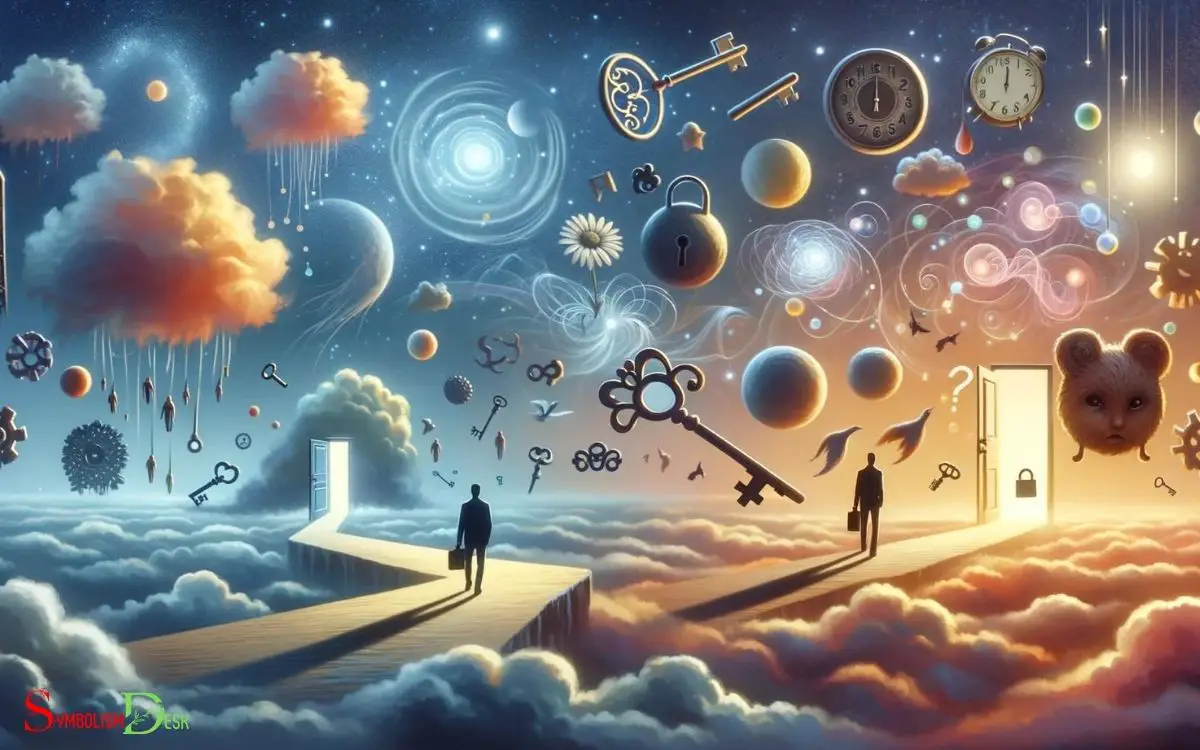Do Dreams Have Symbolic Meaning: Desires!
Dreams can possess symbolic meaning, reflecting deep-seated emotions, desires, and concerns. The interpretation of dream symbols varies across different cultures and psychological frameworks.
Dream symbolism has been studied for centuries, and various approaches have been developed to understand their meanings:
- Psychoanalytic Theory: Sigmund Freud suggested that dreams are a manifestation of repressed desires and emotions.
- Jungian Theory: Carl Jung believed that dreams tap into the collective unconscious and use archetypes that are universal across cultures.
- Modern Psychology: Contemporary studies often view dreams as a way to process emotions and consolidate memories.
Dreams can be a window into our inner world, often revealing truths that our waking minds might overlook or suppress.

Key Takeaway
6 Aspects of Dreams Have Symbolic Meaning
| Aspect | Dreams | Symbolic Meaning |
|---|---|---|
| Definition | Mental experiences during sleep | Interpretation of symbols in dreams |
| Nature | Subconscious narratives | Symbolic representations |
| Interpretation | Varied, subjective | Analyzed for hidden messages |
| Purpose | Unconscious processing | Insight into emotions, psyche |
| Cultural Significance | Diverse across cultures | Universally recognized symbols |
| Psychological Study | Studied by psychologists | Analyzed for symbolism |
The History of Dream Interpretation
Dream interpretation has been a subject of fascination and study for centuries, with various cultures and traditions offering unique perspectives on the significance of dreams.
The earliest recorded evidence of dream interpretation dates back to ancient Mesopotamia, where dreams were believed to convey divine messages.
In ancient Egypt, dreams were thought to be a means of communication with the gods or the deceased.
The Greek and Roman civilizations also placed great importance on the interpretation of dreams, with philosophers such as Aristotle and Artemidorus attempting to unravel their mysteries.
During the Middle Ages, dreams were often viewed through a religious lens, seen as either temptations from the devil or messages from God.
Throughout history, dream interpretation has evolved, influenced by cultural, religious, and psychological factors, shaping the diverse perspectives on the symbolic meaning of dreams.
Theories on Dream Symbolism
Theories on dream symbolism encompass a variety of perspectives, each offering unique insights into the potential meaning behind our dreams.
Freudian dream symbolism delves into the unconscious mind, suggesting that dreams serve as a window into our deepest desires and fears.
Cultural interpretations of dreams highlight how societal norms and values can influence the symbolism we attribute to certain dream elements.
Personalized dream symbolism emphasizes the individualized nature of dream imagery, acknowledging the unique experiences and emotions of each dreamer.
Freudian Dream Symbolism
Sigmund Freud’s theory of dream symbolism explores the unconscious mind’s use of symbolic imagery to express hidden desires and emotions. According to Freud, dream symbols represent unconscious thoughts and repressed conflicts.
His theory suggests that the content of dreams is often a disguise for the fulfillment of unconscious wishes.
Freud believed that dreams provide a safe outlet for the expression of forbidden or socially unacceptable desires, allowing the individual to process and confront these hidden aspects of the psyche.
- Manifest Content vs. Latent Content: Freud proposed that dreams have manifest content, which is the storyline of the dream, and latent content, which represents the hidden psychological meaning of the dream.
- Symbolic Representation: Freudian dream analysis emphasizes the interpretation of symbols and their underlying meanings, suggesting that dream images represent unconscious desires and thoughts.
- Sexual Symbols: Freud believed that many dream symbols have sexual connotations and represent unfulfilled sexual wishes.
Cultural Interpretations of Dreams
Exploring cultural interpretations of dreams involves examining how different societies and belief systems ascribe symbolic meanings to dream imagery, expanding on Freud’s theories of dream symbolism.
In various cultures, dreams are often seen as messages from the divine, ancestors, or the spirit world.
For example, in some indigenous cultures, dream interpretation plays a crucial role in decision-making, healing, and understanding one’s purpose in life.
In Chinese culture, certain animals and objects in dreams hold specific symbolic meanings, influencing how the dreamer perceives the message.
Similarly, in Islamic traditions, dreams are considered a medium through which the unconscious communicates, and the interpretation of dreams is highly valued.
Understanding these cultural interpretations provides insight into the diverse ways in which people perceive and derive meaning from the enigmatic realm of dreams.
Personalized Dream Symbolism
While there are various theories on dream symbolism, one approach to understanding personalized dream symbolism involves exploring the unique associations and meanings that individuals attribute to their dream imagery.
This personalized approach recognizes that dream symbols can hold different significance for each person based on their experiences, emotions, and beliefs.
Some key theories on personalized dream symbolism include:
- Activation-Synthesis Theory: This theory suggests that dreams are the result of the brain’s attempt to make sense of random neural activity during sleep.
- Continual-Activation Theory: According to this theory, dreams reflect ongoing conscious and unconscious thoughts and emotions, leading to personalized symbolic representations.
- Individual Archetypal Symbols: This theory proposes that certain symbols in dreams hold personalized meanings based on an individual’s unique experiences and cultural background.
Common Dream Symbols and Their Meanings
Dream symbols often hold significant meaning and can provide insight into our subconscious thoughts and emotions.
Common dream symbols such as flying, falling, being chased, or teeth falling out, often represent universal experiences and emotions.
For example, flying can symbolize a desire for freedom or escape from constraints, while falling may represent insecurity or loss of control.
Being chased can symbolize avoidance of a particular issue, and teeth falling out may represent concerns about self-image or communication.
Understanding these common symbols can help individuals interpret the messages their dreams are conveying.
However, it’s important to note that the meaning of dream symbols can also be influenced by cultural variations in dream interpretation, which we will explore in the subsequent section.
Cultural Variations in Dream Interpretation
Cultural variations in dream interpretation can significantly influence the meaning attributed to common dream symbols, reflecting the diverse perspectives and values held within different societies.
These variations are evident in:
- Symbolism: Different cultures may attribute distinct meanings to the same dream symbol, such as snakes or water, based on their cultural myths, religious beliefs, or historical experiences.
- Taboos: Certain symbols that are considered positive in one culture may carry negative connotations in another, influencing how dreams are interpreted and perceived.
- Rituals: Cultural practices and rituals surrounding dreams, such as dream incubation or interpretation methods, can shape the way individuals understand and engage with their dreams.
Understanding these cultural diversities is crucial in comprehending the complexities of dream interpretation and its significance within diverse cultural contexts.
Transitioning into the subsequent section about ‘the role of emotions in dream analysis’ requires exploring how emotions intertwine with cultural interpretations.
The Role of Emotions in Dream Analysis
Variations in dream interpretation across cultures necessitate an exploration of the role of emotions in analyzing dreams, illuminating how emotional states intersect with cultural perspectives to shape the understanding and significance of dream symbolism.
Emotions play a crucial role in dream analysis as they often provide valuable insights into an individual’s subconscious thoughts and feelings.
The emotional tone of a dream can influence its interpretation, as feelings of fear, joy, or anxiety can imbue specific symbols or scenarios with particular significance.
Moreover, the cultural context in which an individual is situated can influence the emotions that are evoked by certain symbols or events in a dream.
Therefore, understanding the role of emotions in dream analysis requires an appreciation of both universal psychological principles and the specific cultural and personal contexts in which dreams occur.
Do Dreams Reflect Cultural Symbols and Meanings?
Dreams hold a mysterious power, often reflecting cultural symbols and meanings. From ancient civilizations to modern societies, these symbols shape our dreams and influence our experiences. The meaning of Mexican flag symbols, such as the eagle, serpent, and cactus, may appear in dreams, revealing connections to Mexican heritage and identity. As we explore the depths of our subconscious, dreams offer unique glimpses into the rich tapestry of cultural symbolism that defines who we are.
Practical Tips for Understanding Your Dreams
Understanding the symbolic meaning of dreams can provide valuable insight into the subconscious mind. By recognizing and interpreting the symbolism present in dreams, individuals can gain a deeper understanding of their emotions, fears, and desires.
Practical tips for analyzing dreams can help in unraveling the hidden messages and patterns, ultimately leading to personal growth and self-awareness.
Symbolism in Dream Interpretation
In dream interpretation, the use of symbolism provides practical tips for understanding the meaning of your dreams. Symbolism allows for the exploration of the subconscious mind and can offer valuable insights into one’s emotions, fears, and desires.
When interpreting dreams, it’s important to consider the following:
- Context: Analyze the context in which the symbols appear in your dream. The setting, people involved, and your emotions can all provide clues to the symbolic meaning.
- Personal Associations: Consider the personal significance of the symbols. Certain objects or situations may have unique meanings to individuals based on their personal experiences and beliefs.
- Universal Symbols: Familiarize yourself with universal symbols and archetypes that appear across different cultures and belief systems. Understanding these symbols can provide deeper insight into the collective human experience.
Understanding Subconscious Through Dreams
To gain deeper insight into the subconscious mind through dreams, it is essential to carefully analyze and interpret the symbolic elements present within them. One practical tip for understanding your dreams is to keep a dream journal.
Recording your dreams immediately upon waking can help capture details that might otherwise be forgotten. Additionally, paying attention to recurring themes or symbols in your dreams can provide valuable clues about your subconscious thoughts and emotions.
Engaging in self-reflection and introspection can also aid in understanding the underlying messages in your dreams. Seeking the assistance of a professional dream analyst or therapist can offer further guidance in deciphering the meaning behind your dreams.
Practical Tips for Analysis
Analyzing and interpreting the symbolic elements present in dreams requires careful observation and reflection.
Here are practical tips for understanding your dreams:
- Keep a dream journal: Record your dreams as soon as you wake up to capture all the details and emotions while they’re still fresh in your mind.
- Look for recurring themes: Take note of any recurring symbols, people, or situations in your dreams as they may hold significant meaning.
- Consider personal associations: Reflect on what specific symbols mean to you personally, as dream interpretation is highly individual and can be influenced by your unique experiences and emotions.
Conclusion
The history of dream interpretation spans across cultures and time periods, reflecting the human fascination with the symbolic meaning of dreams.
Theories on dream symbolism vary, but common symbols often reflect universal themes such as fear, desire, and transformation.
Cultural variations in dream interpretation highlight the importance of context and personal experiences.
Emotions play a crucial role in dream analysis, and practical tips can help individuals understand the deeper meanings behind their dreams.
Understanding dream symbolism offers valuable insights into the human psyche and subconscious mind.







